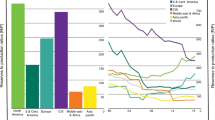Abstract
Coal, the most important fossil fuel in India, accounts for 75% of India's total electricity requirement in Dec 2020 and 51.65% of energy requirement overall as on Dec 2021. Coal contains varying amounts of fixed carbon, volatile matter, ash, moisture, and sulphur. The available coal's specific properties and reduced emissions of impurities such as ash, slag, sulphur, and dioxins must be considered while designing coal-fired thermal power plants. Coal properties that affect combustion and environmental performance, namely gross calorific value, moisture, sulphur, and ash content, often form the basis of sales contracts between coal-producing companies and coal-fired power plants. Indian coal quality shows wide variation from coalfield to coalfield, from mine to mine and even from coal seam to seam within a coalfield, depending upon their depth of occurrence and composition. This paper attempts to develop a multiple linear regression model to assess the gross calorific value of coal. This model uses gross calorific value on Air-Dried Basis (ADB) as a dependent variable and moisture content, ash content and humidity percentage as independent variables, also on Air-Dried Basis. A scatterplot between the percentage of ash content in collected coal samples from Indian opencast mines and the gross calorific value of coal indicated a strong negative correlation between them. This model's performance was assessed and confirmed its applicability in evaluating the gross calorific value of coal. The quick assessment of gross calorific value using this model can help identify the area of a specific grade, which facilitates separate stockpiling of coal based on the sales contracts and a more accurate economic valuation of the entire coal reserve.










Similar content being viewed by others
References
Power sector at a glance all India. https://powermin.gov.in/en/content/power-sector-glance-all-india Accessed 06 Sep 2022.
O.C. Kopp, M.E. Bennett Iii, and C.E. Clark, Volatiles lost during coalification. Int. J. Coal Geol. 44(1), 69–84 (2000)
E. Kowalska and P. Urbanski, Measurement of ash content in lignite from Mongolian mines. (2004)
P. Zuzaan, Some results of a study to determine coal quality and elements contents, Proc. of the 3rd Intern. School on Contemporary Physics (ISCP-3), Ulaanbaatar. pp. 100–103 (2005)
R. Gupta, Advanced coal characterization: a review. Energy Fuels 21(2), 451–460 (2007)
N. Soundarrajan, N. Krishnamurthy, S.V. Pisupati, Physical and Chemical Characterization of coal particles used as entrained flow gasifier feedstock: heterogeneity in mineral matter distribution. Energy Procedia. 14, 1735–1740 (2012)
D. Bolortuya, P. Zuzaan, M.V. Gustova, O.D. Maslov, Study of the correlation between the coal calorific value and coal ash content using X-ray fluorescence analysis. Phys. Part. Nucl. Lett. 10(7), 723–726 (2013)
N.R. Cheepurupalli, G.V.S. Sharma, C.S. Singh, E.N.D. Rao, Petrographic analysis and its relationship with calorific values of non-coking coals, Talcher Coalfield, Orissa. Int. J. Eng. Trends Technol. 30, 13–20 (2015)
D. Mahapatra, A Review on Steam Coal Analysis-Moisture. American International (2015)
P. Modi, A. Jamal, and N. Singh, Coal characterization and occurrence of rare earth elements in coal and coal-ash of Sohagpur Coalfield, Madhya Pradesh, India. International Journal of Coal Preparation and Utilization pp. 1–14, (2021)
D. Mahapatra, A review on steam coal–sampling and preparation. Am. Int. J. Res. Sci. Technol. Eng. Math. 13(1), 1–9 (2016)
J. Parikh, S.A. Channiwala, G.K. Ghosal, A correlation for calculating HHV from proximate analysis of solid fuels. Fuel 84(5), 487–494 (2005)
I. Standard, Methods of test for coal and coke: proximate analysis (Second Revision). (1984)
P.M.B.L.C. Brown and D.F. Hambley, Statistics for environmental engineers. Association of Environmental and Engineering Geologists (2002)
A. Chaloulakou, G. Grivas, N. Spyrellis, Neural network and multiple regression models for PM10 prediction in Athens: a comparative assessment. J Air Waste Manage Assoc 53(10), 1183–1190 (2003)
N.W. Polhemus, How to: deal with multicollinearity when fitting a regression model using statgraphics centurion. Statpoint Technologies Inc. (2005)
D.C. Montgomery, E.A. Peck, and G.G. Vining, Introduction to linear regression analysis. John Wiley and Sons (2021)
P. Goyal, A.T. Chan, N. Jaiswal, Statistical models for the prediction of respirable suspended particulate matter in urban cities. Atmos. Environ. 40(11), 2068–2077 (2006)
D.K. Papanastasiou, D. Melas, I. Kioutsioukis, Development and assessment of neural network and multiple regression models in order to predict PM10 levels in a medium-sized mediterranean city. Water. Air Soil. Pollut. 182(1), 325–334 (2007)
Acknowledgements
The support from the Department of Mining Engineering, IIT (BHU), Varanasi, is acknowledged. Authors are also grateful to the management of Northern Coalfields Limited and South-Eastern Coalfields Limited, which are subsidiary companies of Coal India Limited, for providing the necessary facilities during the field study.
Funding
The authors declare that no funds, grants, or other support were received during the preparation of this manuscript.
Author information
Authors and Affiliations
Corresponding author
Ethics declarations
Conflict of interest
The authors declare that they have no conflict of interest.
Additional information
Publisher's Note
Springer Nature remains neutral with regard to jurisdictional claims in published maps and institutional affiliations.
Rights and permissions
Springer Nature or its licensor (e.g. a society or other partner) holds exclusive rights to this article under a publishing agreement with the author(s) or other rightsholder(s); author self-archiving of the accepted manuscript version of this article is solely governed by the terms of such publishing agreement and applicable law.
About this article
Cite this article
Singh, N.P., Seervi, V., Meena, S.K. et al. Development of Multiple Regression Model for Assessment of Coal Calorific Value in Indian Opencast Mines. J. Inst. Eng. India Ser. D 104, 503–514 (2023). https://doi.org/10.1007/s40033-022-00444-9
Received:
Accepted:
Published:
Issue Date:
DOI: https://doi.org/10.1007/s40033-022-00444-9




